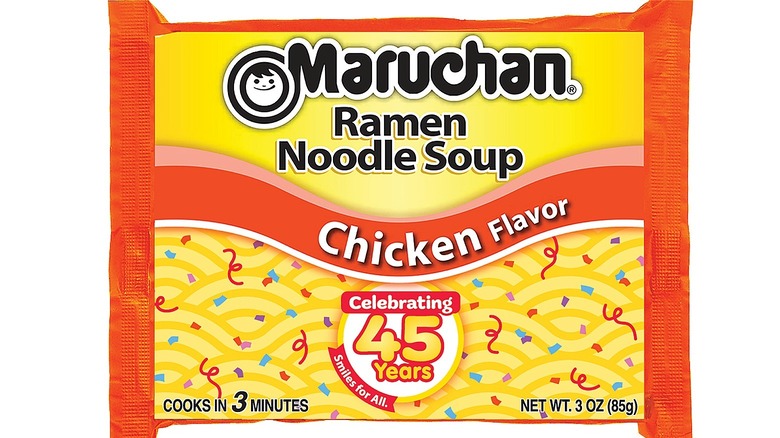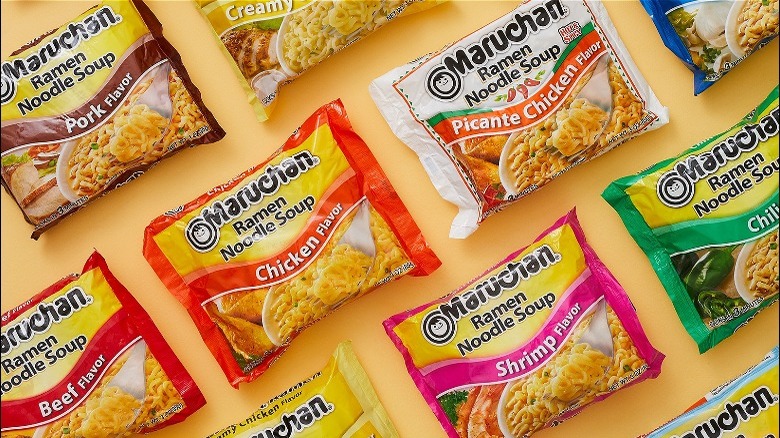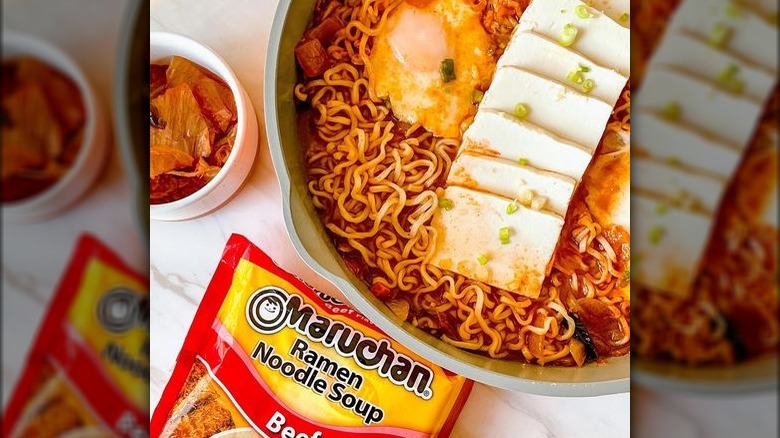Maruchan Is Turning 45. Here's How It Has — And Hasn't — Changed Over The Years
Instant ramen has been a staple of college dorm rooms for ages. And this year, favorite brand Maruchan is celebrating 45 years of operations in the United States. Maruchan was first established in 1953 in Japan as a frozen fish distribution company, but it pivoted to producing instant ramen in 1961. On the success of its Japanese company, Maruchan ventured into the U.S. market in 1977, opening a factory in California, and becoming the well-known noodle company fans know today.
Maruchan has come a long way since its first ventures, and its popularity continues to increase. According to YouGov, in 2020, Maruchan was ninth on the list of brands with the biggest growth in brand health based on reputation and customer recommendations. In fact, two Maruchan products, the creamy chicken and chicken, made Wirecutter's list of the best instant noodles, with judges citing them both for taste and nostalgia.
The Maruchan name itself is a conglomeration of two different Japanese words: "maru," which means "round," and "chan" which is an honorific — basically a suffix — that is added to a word or name and used when something is cute or endearing, often for children, but can be for friends, young women, or animals (per Busuu). Hence, the logo with the round smiling child's face.
The company has added a lot of products since it started
According to the company, the packages we know as Instant Lunch and Instant Ramen were already manufactured in Japan when Maruchan opened in the United States in 1977. Soon after coming to the United States, Maruchan also began offering boxed wonton soup. It was discontinued, but according to Maruchan Consumer Affairs, it's once again available at select grocery stores and online.
Maruchan has come a long way since its small beginnings, broadening not just the number of Maruchan ramen flavors available, but also adding yakisoba and ramen bowls. While the basic chicken and beef are long-time favorites, the company has added more Americanized versions over the years, including picante chicken ramen and lime chili shrimp ramen, as well as cheddar yakisoba and fire yakisoba. The company has also added a new Maruchan Gold line, aiming for a higher end, premium instant noodle, closer to a restaurant-quality ramen with a traditional-style broth and a liquid seasoning packet, Brand Eating notes.
Even the slogan has changed over the years. When the company first came to the United States, it referred to itself as "America's finest ramen noodle soup," according to the company. But lately, Maruchan has adopted a more cheerful "Smiles for All" slogan, a play on the smiling logo.
Fans also get creative with their Maruchan noodles
Maruchan fans are known for making hacks and variations of the different flavors. On its Facebook page, Maruchan pointed to one combination of the chicken and shrimp ramen, a concoction it referred to as "Chicken and the Sea." And Tasty has a whole list of recipes to that start with Maruchan chicken ramen and butter to create a wide variety of dishes seemingly gourmet dishes, featuring everything from Thai coconut curry ramen to bacon and egg ramen.
And Tiktok user @insta.noodles, aka "The Ramen Guy," ate his way through a variety pack box of all the different Maruchan flavors. Others have taken up Kylie Jenner's instant ramen hack of adding eggs, garlic powder, and butter, with one TIkToker even adding Japanese sweet Kewpie mayo as well and using chopped garlic instead. Food blogger @mawnie.eats shared a recipe on her Instagram for kimchi soondobu ("soft tofu") with noodles instead of rice, which Maruchan later featured on its Instagram page.
And for the ultimate Maruchan fan, the internet is rife with Maruchan merchandise, with everyone from Amazon to Walmart to RedBubble selling t-shirts, pajama pants, cell phone cases, and more. So, you can wear your ramen and eat it, too.


